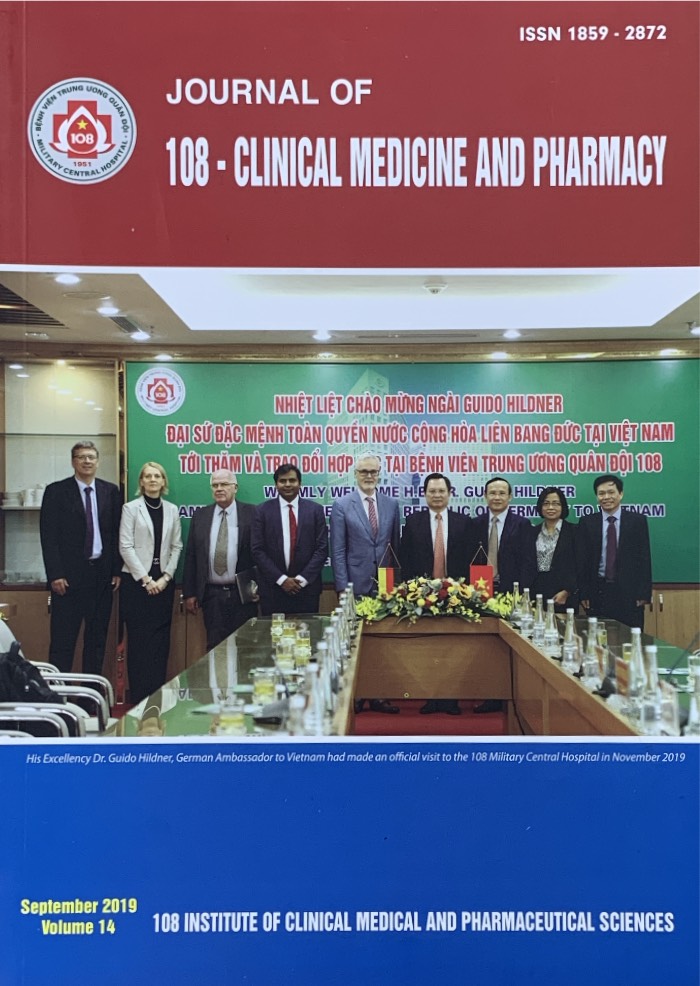Relation between BRAF V600E mutation and 18F-FDG avidity in radioiodine refractory differentiated thyroid carcinoma
Main Article Content
Keywords
Tóm tắt
Objective: The BRAF V600E mutation is one of the prognostic factors in thyroid carcinoma related to GLUT-1 expression which increases FDG uptake. In this study, we investigated the relationship between BRAF V600E mutation, clinicopathologic factors and 18F-fluoro-2-deoxyglucose (18F-FDG) avidity in radioiodine-refractory differentiated thyroid carcinoma (DTC). Subject and method: Total 46 radioiodine-refractory DTC patients who underwent BRAF V600E analysis from the biopsy and 18F-FDG positron emission tomography/computed tomography from 2011 to 2018. Semi-quantitative analysis of highest hypermetabolic lesion was accessed by automated polygonal regions of interest (ROIs) drawing on attenuation-corrected PET images the Workstation AW4.7 (GE). The relationship between BRAF mutation, clinicopathologic factors, and 18F-FDG avidity was investigated. Result: Patients with the BRAF V600E mutation present higher 18F-FDG uptake (median of SUVmax: 7.11) than those without mutation (median of SUVmax: 4.91) but the difference is not statistic significance (p=0.236). The tumor size (p=0.006) and distant metastases (0.03) were significantly associated with 18F-FDG uptake in univariate analysis. Aggressive histopathologic type of DTC was only the factor (p = 0.01) related to FDG uptake significantly (p=0.01) in both univariate and multivariate analysis. Conclusion: The aggressive and classic type of DTC were the factors significantly related to 18F-FDG avidity in both univariate and multivariate analysis. The effect BRAF V600E of mutation on glucose metabolism in radio iodine refractory patients needs further study in larger groups of patients.
Article Details
Các tài liệu tham khảo
2. Durante C, Haddy N, Baudin E, Leboulleux S, Hartl D, Travagli JP et al (2006) Long-term outcome of 444 patients with distant metastases from papillary and follicular thyroid carcinoma: Benefits and limits of radioiodine therapy. The Journal of clinical endocrinology and metabolism 91(8): 2892-2899.
3. Son MH, Bieu BQ, Ha LN (2016) Value of dedicated head and neck 18F-FDG PET/CT protocol in detecting recurrent and metastatic lesions in post-surgical differentiated thyroid carcinoma patients with high serum thyroglobulin level and negative 131I whole-body scan. Asia Oceania Journal of Nuclear Medicine and Biology 4(1): 12-18.
4. Caetano R, Bastos CR, de Oliveira IA, da Silva RM, Fortes CP, Pepe VL et al (2016) Accuracy of positron emission tomography and positron emission tomography-CT in the detection of differentiated thyroid cancer recurrence with negative (131) I whole-body scan results: A meta-analysis. Head & neck 38(2): 316-327.
5. Lee SH, Han S, Lee HS, Chae SY, Lee JJ, Song DE, et al (2016) Association between (18)F-FDG avidity and the BRAF mutation in papillary thyroid carcinoma. Nuclear medicine and molecular imaging 50(1): 38-45.
6. Mian C, Barollo S, Pennelli G, Pavan N, Rugge M, Pelizzo MR et al (2008) Molecular characteristics in papillary thyroid cancers (PTCs) with no 131I uptake. Clin Endocrinol (Oxf) 68(1): 108-116.
7. Haugen BR, Alexander EK, Bible KC, Doherty GM, Mandel SJ, Nikiforov YE et al (2016) 2015 American thyroid association management guidelines for adult patients with thyroid nodules and differentiated thyroid cancer: The American thyroid association guidelines task force on thyroid nodules and differentiated thyroid cancer. Thyroid 26(1): 1-133.
8. Yoon S, An Y-S, Lee SJ, So EY, Kim J-H, Chung Y-S et al (2015) Relation between F-18 FDG uptake of PET/CT and BRAF V600E mutation in papillary thyroid cancer. Medicine 94(48): 2063.
9. Yoon M, Jung SJ, Kim TH, Ha TK, Urm SH, Park JS, et al (2016) Relationships between transporter expression and the status of BRAF V600E mutation and F-18 FDG uptake in papillary thyroid carcinomas. Endocrine research 41(1): 64-69.
10. Ozderya A, Temizkan S, Gul AE, Ozugur S, Sargin M, Aydin K (2017) Correlation of BRAF mutation and SUVmax levels in thyroid cancer patients incidentally detected in (18)F-fluorodeoxyglucose positron emission tomography. Endocrine 55(1): 215-222.
11. Durante C, Puxeddu E, Ferretti E, Morisi R, Moretti S, Bruno R et al (2007) BRAF mutations in papillary thyroid carcinomas inhibit genes involved in iodine metabolism. The Journal of clinical endocrinology and metabolism 92(7): 2840-2843.
12. Romei C, Ciampi R, Faviana P, Agate L, Molinaro E, Bottici V et al (2008) BRAF V600E mutation, but not RET/PTC rearrangements, is correlated with a lower expression of both thyroperoxidase and sodium iodide symporter genes in papillary thyroid cancer. Endocr Relat Cancer 15(2): 511-520.
13. Feine U, Lietzenmayer R, Hanke JP, Held J, Wohrle H, Muller-Schauenburg W (1996) Fluorine-18-FDG and iodine-131-iodide uptake in thyroid cancer. Journal of nuclear medicine: Official publication, Society of Nuclear Medicine 37(9): 1468-1472.
 ISSN: 1859 - 2872
ISSN: 1859 - 2872
